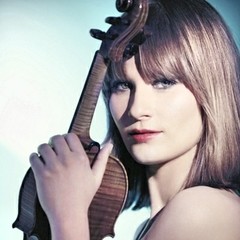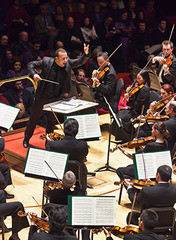|
Back
Two Views of Transcendence New York
Isaac Stern Auditorium, Carnegie Hall
05/02/2014 - & May 1, 3, 2014 (Philadelphia)
Samuel Barber: Adagio for Strings, Opus 11
Béla Bartók: Violin Concerto No. 1, sz. 36
Anton Bruckner: Symphony No. 9 in D Minor
Lisa Batiashvili (Violinist)
Philadelphia Orchestra, Yannick Nézet-Séguin (Music Director and Conductor)

L. Batiashvili (© Courtesy of the Artist)
If the Philadelphia Orchestra wanted to show off a glistening string section last night, their two works in the first half of last night’s program were a success. In a concert of three different B’s, the first two were well aware of how to paint string colors.
Beginning was one of those works which–ever since Oliver Stone used it in a movie–achieved iconic success. But Samuel Barber’s Adagio (which gained earlier fame as the only American work conducted by Arturo Toscanini) is still a virtuoso work, not only for strings but for conductor. The Philadelphia Orchestra’s Yannick Nézet-Séguin took advantage of those retardations, of Barber’s phrasing which almost can fall into schmaltz, and let his strings attain the status of a chorale.
Granted, Mr. Barber’s de facto liturgical work seemed rather picayune by the end of the program, but we come to that later.
In the meantime, we New York critics had better learn now to spell the Georgian-born Lisa Batiashvili correctly, since she will be artist-in-residence with the New York Philharmonic next season. For a preview, she performed a rare work by Béla Bartók, an early Violin Concerto which originally was anachronistically called “opus posthumous.” Quite the opposite. He composed it when a young lad in 1907, though it wasn’t revealed again until after its death.
While it can’t compare in complexity or unity with the Second Violin Concerto, this one has its sheerly Bartókian moments, from its deceivingly quiet opening moments to interpolated circus music at the end. And for those not into Bartók, its brevity itself counts for something.
So does Ms. Batiashvili. She is hardly a flashy fiddler. In fact, there is a coolness to her playing, her long phrases in the first movement seemed almost uncomfortably taut. Even in the most emotional sounds of the last movement, she seemed to hold back, as if not to give away too much of her musical heart.
But oh, when she reached the high notes in that movement, her Guarneri del Gesù sung with unexpected color, rays of musical sunlight made all the more radiant in this understated performance.

Y. Nézet-Séguin and Philadelphia Orchestra (© Chris Lee)
When mentioned above that the Barber liturgy lost its luster in the second half, I was referring to Bruckner’s hour-long Ninth Symphony, a farewell work which might have gone far longer had he finished writing the finale.
To those who think of Maestro Nézet-Séguin as a flashy Montreal-Gallic conductor, they had another thought coming. From his earliest days in Montreal, he had shared a love affair with Anton Bruckner. And if his Canadian orchestra wasn’t quite up to the standards that he wanted with Bruckner, he managed to sculpt them with a Rodinesque ear, so that their recordings of the composer are splendid examples of a young conductor at work.
With the Philadelphia Orchestra, he has had time for more interpretation, and last night his Bruckner had so many moments of sheer religious transcendence, Wagnerian symphonic power and of course an orchestra which knew that they were doing, that one never thought of the time.
The Maestro began with perhaps a broad, sometimes too fast opening. But when that second theme came long, it never had the tumescent sound which even the best Central European orchestras have. It was refreshing, it moved steadily, the conductor rarely went to extremes in rubati but kept the dynamism. Many a conductor sees Bruckner’s religiosity as something stolid. But Bruckner was apparently a great organist, and he recognized that Bach wasn’t a mere contrapuntalist, but a melodist. Bruckner still writes those melodies (if disguised by drums and trumpets), and Mr. Nézet-Séguin retained what some conductors attend to least: that his music can soar with the best of the late romantics.
The scherzo was played with more than the usual excitement. Rather, a happy dichotomy of grace and drum-pounding excitement, the stuff that may have given the conductor a needed change of pace.
But it is the finale (rather the penultimate movement for Bruckner’s “Unfinished” symphony), where any conductor makes his/her mark. To “enjoy it” (as the people in front of me said) is hardly enough. One must be moved enough to go to Confession or (at least in my case) to feel mea culpa for being an atheist. I’m not certain that the conductor had one particular feeling for the movement, where the sounds ranged from the most glorious string choirs to some mundane wind intermezzi.
Yet Mr. Nézet-Séguin is such a master of the Philadelphia, the one never worried about the single picture he was about to create. Bruckner did the hard part, Mr. Nézet-Séguin allowed the notes to speak for themselves. And if Carnegie Hall wasn’t quite turned into a cathedral, he made translated the music into sometimes towering music for the finest churches.
Harry Rolnick
|